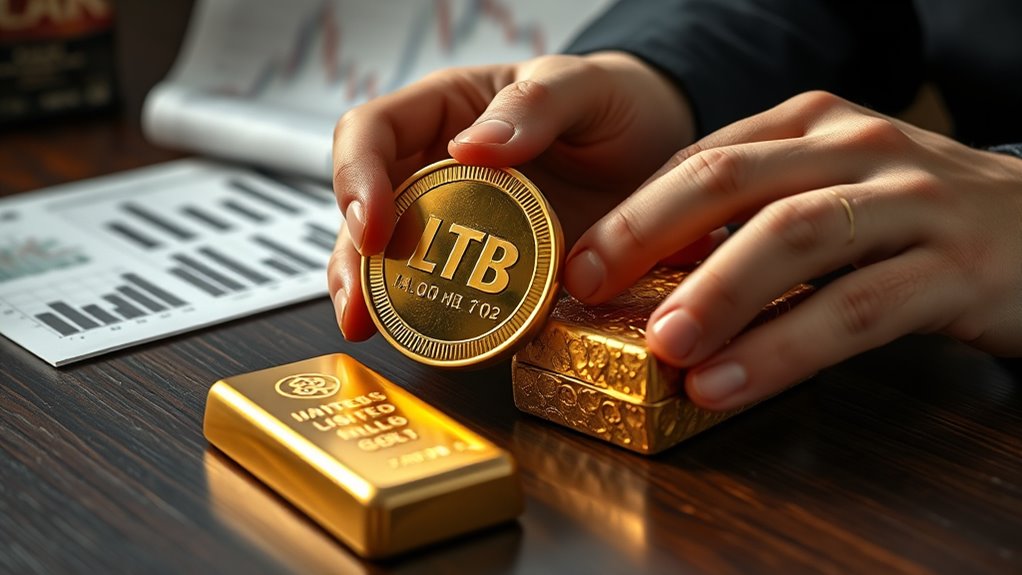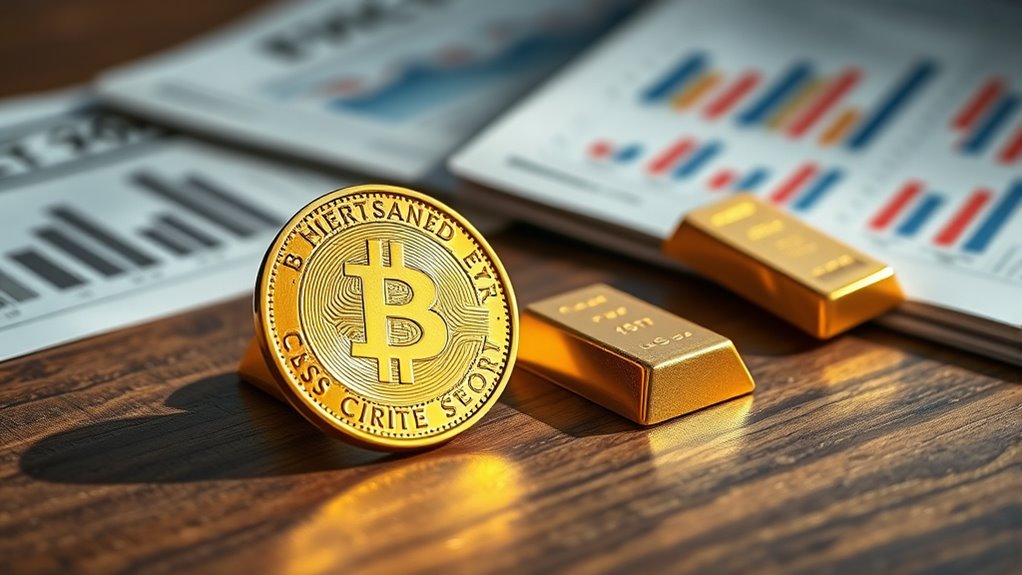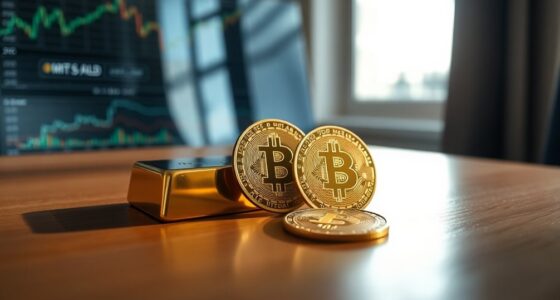To hedge a bond-heavy IRA without sacrificing yield, consider adding gold ETFs. They offer liquidity, flexibility, and cost-effectiveness compared to physical bullion. Gold ETFs can protect your portfolio against inflation and economic downturns while allowing quick adjustments as market conditions change. They also help offset bond risks during volatility. If you explore further, you’ll uncover how to optimize your hedge strategy and maximize your long-term returns effectively.
Key Takeaways
- Gold ETFs offer liquidity and quick trading to hedge bond risks without sacrificing yield or dealing with physical storage.
- They provide inflation protection, helping offset bond devaluation during economic downturns.
- Compared to bullion, ETFs typically have lower costs and easier access, maintaining portfolio efficiency.
- Gold ETFs can be rebalanced easily, avoiding the delays and complexities of liquidating physical gold.
- They enable bond-heavy portfolios to diversify risk while preserving potential returns.

Hedging a bond-heavy IRA with gold ETFs offers a strategic way to protect your portfolio against inflation and economic downturns. When your goal is to reduce interest rate risk and diversify your holdings, gold ETFs provide a flexible, cost-effective option. Unlike physical gold, these exchange-traded funds track the price of gold without requiring you to own or store physical metal. Instead, your shares represent a stake in a trust holding gold, making it easier to buy and sell. This setup allows you to maintain liquidity and quickly adjust your hedge as market conditions change, unlike physical gold, which can be less accessible and more cumbersome to liquidate. Gold ETFs are regulated by the SEC, providing an added layer of investor protection and transparency.
One of the main advantages of gold ETFs is their lower overall costs. With expense ratios typically ranging from 0.25% to 0.40% annually, they are more affordable than physical gold IRAs that involve storage, insurance, and custodian fees. These additional expenses can substantially increase the cost of holding physical gold, especially over time. While brokerage fees may apply when buying or selling ETF shares, they tend to be manageable, particularly for investors seeking smaller or more frequent transactions. Additionally, the tax treatment of gold ETFs differs from physical gold; ETFs are taxed as collectibles, with higher long-term capital gains rates of up to 28%, whereas physical gold in an IRA benefits from tax-deferred growth. This distinction can influence your overall return, especially if you plan to hold for the long term.
Gold ETFs are highly liquid, traded throughout market hours on stock exchanges. This liquidity enables you to execute quick trades, reposition your hedge, or respond to shifting economic signals without delay. In contrast, liquidating physical gold within an IRA can be more complex and time-consuming, often involving multiple steps to sell the metal, transfer funds, and meet custodial requirements. Additionally, ETF prices can fluctuate due to market factors, sometimes deviating slightly from the spot gold price because of tracking errors. Frequent trading may incur transaction costs and slippage, which can impact your returns. While physical gold offers stability as a tangible asset, it may delay access to funds after selling, limiting your ability to react swiftly to market developments.
Incorporating gold ETFs into a bond-heavy IRA helps offset the negative effects of rising inflation and declining bond prices. They provide exposure to gold’s price movements without sacrificing yield or taking on ownership complexities. This diversification can reduce interest rate risk and improve your portfolio’s resilience during economic turbulence. The ease of rebalancing with ETFs allows you to fine-tune your hedge levels according to market conditions, maintaining liquidity and flexibility. As market volatility increases, having such adaptable instruments becomes even more beneficial. However, keep in mind the inherent market risks, including price volatility and tracking errors, as well as the counterparty risk associated with financial institutions. Overall, gold ETFs present a practical, accessible way to hedge your bond-heavy IRA while preserving growth potential and liquidity.
Frequently Asked Questions
Can Gold ETFS Completely Eliminate Bond Portfolio Risk?
Gold ETFs can’t completely eliminate bond portfolio risk. While they help reduce interest rate and inflation risks and can act as a safe haven during market downturns, they don’t offer fixed income or coupon payments like bonds do. You still face volatility and specific issuer risks, so adding gold ETFs improves overall risk management but doesn’t fully replace the stability bonds provide. Balancing both assets creates a more resilient portfolio.
How Does Gold ETF Liquidity Compare to Physical Gold?
You’re curious about how gold ETFs compare to physical gold in liquidity. Gold ETFs are highly liquid, allowing you to buy or sell shares during trading hours easily, just like stocks. In contrast, physical gold is less liquid; selling it can take longer because of verification, negotiation, and storage considerations. With ETFs, you get quick access to your funds, making them a more flexible option for active investors.
Are There Tax Advantages to Using Gold ETFS Over Bullion?
Imagine your gold investments as a rebellious rock band—one plays loud and fast, the other slow and steady. Using gold ETFs, you enjoy tax advantages like no RMDs and tax-deferred growth, making your portfolio dance smoothly without the IRS knocking. Bullion, while solid, faces higher storage costs and tax implications. So, if you want flexible, tax-efficient gains, ETFs are your star performers over physical gold.
What Are the Costs Associated With Trading Gold ETFS?
When trading gold ETFs, you should consider several costs. You’ll pay an expense ratio that’s deducted from returns, often low, like 0.09% to 0.18%. Trading involves brokerage commissions unless you use a commission-free platform, and bid-ask spreads can add to your costs, especially with less liquid ETFs. These factors impact your overall cost, but ETFs typically offer a cost-effective, liquid way to invest in gold compared to physical bullion.
How Quickly Can Gold ETFS Respond to Market Downturns?
Gold ETFs respond to market downturns faster than a lightning strike, thanks to their high liquidity and real-time trading on stock exchanges. You can see their prices shift within seconds or minutes, closely tracking physical gold’s spot price. During turbulent times, inflows and high trading volumes enable these ETFs to adjust swiftly, acting as a reliable safe haven. Their quick response helps you reallocate assets efficiently amidst market volatility.
Conclusion
By choosing gold ETFs over bullion, you can effectively hedge your bond-heavy IRA without sacrificing yield. Remember, gold has outperformed bonds in recent decades, with a compound annual growth rate of about 10% since 1970. This means your portfolio gains a powerful shield against inflation and market downturns, all while maintaining growth potential. So, next time you consider your IRA strategy, think about how a gold ETF might offer that perfect balance of protection and profitability.








